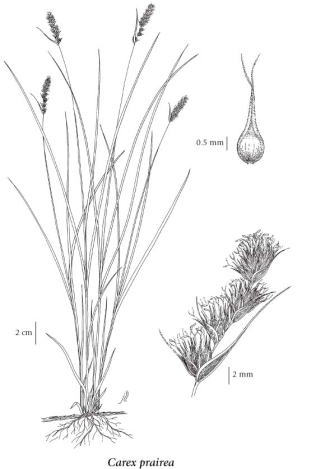Carex prairea Dewey ex Alph. Wood
prairie sedge
Cyperaceae (Sedge family)
Introduction to Vascular Plants
prairie sedge
Cyperaceae (Sedge family)
Introduction to Vascular Plants
Species Information
General:
Perennial, tufted herb from short, slender rhizomes; stems 30-100 cm tall, roughened on the angles, longer than the leaves.
Leaves:
Sheaths coppery-coloured at the tips, conspicuously red-dotted, with glandular projections on the side nearest the stem, the blades of the lower leaves large, firm, persistent; blades 3 to 4 per stem, mostly from near the bases, 1-2.5 (3) mm wide, flat, the margins rolled-under.
Flowers:
Spikes numerous in a narrow, interrupted, 4- to 8-cm long head, cylindrical to egg-shaped, few-flowered, 3-6 mm long, 2.5-4 mm wide, erect or mostly ascending, usually with both female and male flowers, the male flowers towards the tips, at least in the terminal one; bracts inconspicuous, often similar to the female scales, the lowest one often prolonged into an awn.
Fruits:
Perigynia broadly lanceolate, 2.5-3 mm long, 0.7-1.2 mm wide, straw-coloured to brownish, biconvex, smooth, faintly nerved, sharp-edged, short-stalked, finely toothed above, the beaks nearly as long as the bodies, entire; female scales egg-shaped, as long and wide as the perigynia, pointed, light reddish-brown, the centres lighter, the margins translucent; stigmas 2; achenes lens-shaped, 1.2-1.4 mm long.
Illustration

If more than one illustration is available for a species (e.g., separate illustrations were provided for two subspecies) then links to the separate images will be provided below. Note that individual subspecies or varietal illustrations are not always available.
Illustration Source: The Illustrated Flora of British Columbia
Ecology
Ecological Framework for Carex prairea
The table below shows the species-specific information calculated from
original data (BEC database) provided by the BC Ministry of Forests and Range.
(Updated August, 2013)
The table below shows the species-specific information calculated from
original data (BEC database) provided by the BC Ministry of Forests and Range.
(Updated August, 2013)
| Site Information |
Value / Class |
||
|
Avg |
Min |
Max |
|
| Elevation
(metres) |
1107 | 970 | 1168 |
| Slope
Gradient (%) |
0 | 0 | 0 |
|
Aspect (degrees) |
0 | ||
| Soil
Moisture Regime (SMR) [0 - very xeric; 4 - mesic; 8 - hydric] |
6 | 6 | 7 |
| Modal
Nutrient Regime
Class |
E | ||
| #
of field plots species was recorded in: |
6 | ||
| Modal
BEC Zone Class |
SBPS | ||
|
All BEC Zones (# of stations/zone) species was recorded in |
IDF(3), SBPS(3) | ||
|
Source:
Klinkenberg 2013
|
|||